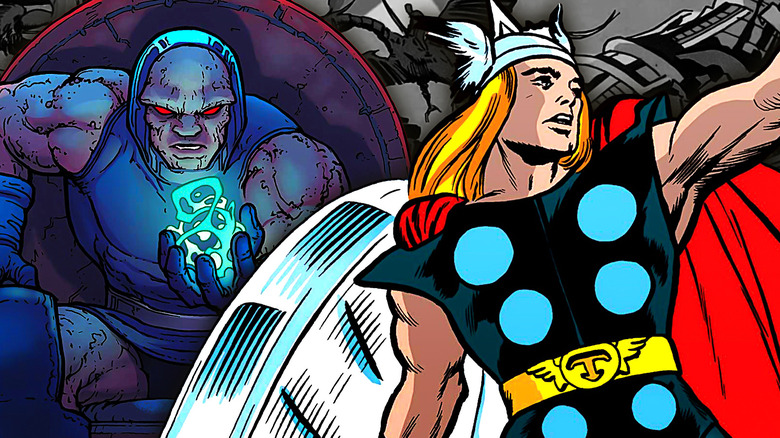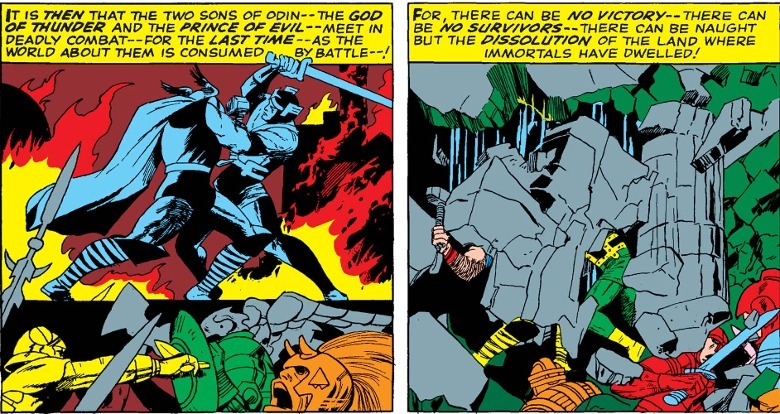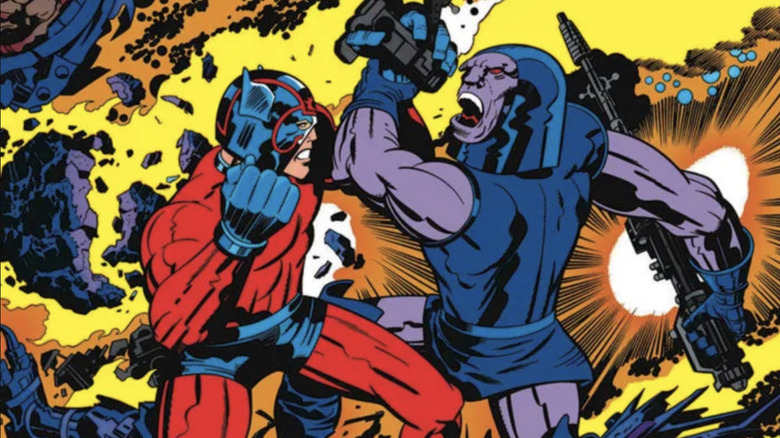One Of DC's Most Evil Villains Could've Been A Marvel Comics Character Instead
Who is the creator of the Marvel Comics universe? It's a trick question, with too many possible answers for a correct one, but most would probably say former Marvel Editor-in-Chief Stan Lee. Others, though, will contend more credit should go to Lee's greatest collaborator (with apologies to Steve Ditko): Jack Kirby. In "Fantastic Four," writer Mark Waid and artist Mike Wieringo depicted the Marvel Universe's God, the one above all, as being Jack Kirby himself.
The co-creator of Captain America with Joe Simon back in the day, Kirby saw his most prolific work in the 1960s. He and Lee created the Fantastic Four, Doctor Doom, Galactus and the Silver Surfer, the Hulk, the X-Men, Magneto, the Mighty Thor, and more. The dispute comes from the idea that Lee misrepresented his earned credit; that Kirby was doing most of the work and Lee was only performing his duties as an editor. (Lee's famous innovation was the "Marvel method" of comics, where he'd come up with a general idea, the artist would draw 20 pages, and he'd fill in dialogue.)
What is indisputable is that Kirby eventually became so dissatisfied at Marvel that he jumped ship to DC Comics in 1970. It was there he drew one of his most beloved creations: the Fourth World, home of the New Gods. After a cataclysmic war that destroyed the "Old Gods," their homeworld split into two. The New Gods are spread across these two halves: the lush and free New Genesis and the dystopian hellscape Apokolips.
Apokolips is ruled by the stone-skinned tyrant Darkseid. (Named as in "the dark side of man's nature," as confirmed by Kirby's former assistant/current scholar Mark Evanier.) Kirby believed that "gods are giant reflections of ourselves." As the God of Evil, Darkseid embodied tyrants old and new, from the Pharaoh in the Book of Exodus to Adolf Hitler. That's why Darkseid's goal is discovering the Anti-Life Equation, the mathematical proof that life is meaningless. Experiencing the equation destroys a being's free will, turning them into an automaton; not dead, but not alive either. Hence, "Anti-Life."
The pervasiveness of evil can rob you of hope, of the will to resist it, and so final victory for Darkseid would be him permanently snuffing out those sparks of life. More than 50 years after his debut, Darkseid stands as the ultimate evil of the DC Universe — but had a butterfly flapped its wings in the other direction, he could've been a Marvel Comics villain instead.
The New Gods were originally meant to replace Marvel's Thor
Of the Marvel comics he helped make, Kirby seemed most passionate about the Fantastic Four and Thor. As a real mythological figure, Thor had grandeur that other superheroes didn't (see new comic "Immortal Thor" for more proof of this). That appealed to Kirby, who was an artist and wanted to work like one — to tell stories that explored big ideas instead of drawing inside the lines of the Marvel house style.
A key part of the Norse myths is Ragnarok, a massive cataclysm when all the Norse pantheon will die. Kirby's "Thor" comics teased this event (prominently in the "Tales of Asgard" back-up feature in "Thor" #127-128), but apparently he wanted to follow through on it. His idea is that Thor and the Gods of Asgard would die in Ragnarok, and then New Gods would emerge from that destruction.
As documented by comic historian Brian Cronin at CBR, Kirby began developing the New Gods while working at Marvel, but decided against pitching them. This was an idea he wanted to develop on his own terms (and get a deserved heavier slice of the profits). If Kirby had been feeling better about his relationship with Marvel, he might've shared these ideas and the Fourth World would be part of Marvel's Comic Universe. Instead of Thanos, the silver screen Avengers would be fighting Darkseid. (More on that soon.)
Then DC Comics Editor Carmine Infantino recruited Kirby, so he brought the New Gods with him to his new home and finally put his ideas into publication. "New Gods" #1 opens with a prologue explaining that, "There came a time when the Old Gods died!" The page shows their deaths, with imagery similar to how Kirby drew Ragnarok in "Thor."
Kirby couldn't officially say it since he was working outside of Marvel's sandbox now, but to him, those Old Gods were Thor and his fellow Norse Gods. "Justice League" episode "Twilight," which prominently features the Fourth World, even gestures at the Thor connection with its title. (A common English translation of "Ragnarok" is "Twilight of the Gods.")
Kirby based a lot of the Fourth World characters on real people. Big Barda, for instance, was inspired physically by Lainie Kazan and in personality by Kirby's wife Roz. A much less flattering caricature was Funky Flashman, a con artist modeled on Stan Lee. According to Evanier, Kirby based Darkseid (his face at least) on actor Jack Palance.
The lead of the Fourth World is not Darkseid, though, but his son: Orion. In a Moses-like twist, Orion was raised not by Darkseid but on New Genesis by its leader, Highfather. As part of a pact between the two worlds, Highfather and Darkseid exchanged sons. (Darkseid got the boy who became Scott Free/Mister Miracle.)
A climactic battle between Darkseid and Orion, father and son, was inevitable — until DC prematurely canceled the Fourth World. Sadly, Kirby and DC wasn't too happy a marriage either, and he'd later go back to Marvel in 1976.
How later DC writers have reinterpreted Darkseid
Kirby got to conclude the Fourth World on his own terms in 1985 with the graphic novel "The Hunger Dogs." New Genesis is destroyed and its people become nomads, while Darkseid is left all alone after the oppressed people of Apokolips finally rise up against him.
Nevertheless, the same thing that Kirby had grown sick of at Marvel happened at DC; his personal mythos became part of a corporate-controlled story. In modern DC comics, Darkseid is more often an adversary of Superman and the Justice League, not Orion and New Genesis.
In a way, Darkseid also did become a Marvel villain though — Jim Starlin, a writer then over at Marvel, was a fan of Kirby's New Gods. So, when writing "Iron Man" #55 in 1973, he debuted a character right out of the Fourth World: Thanos the Mad Titan, based both on Darkseid and his fellow New God, Metron. Unlike Darkseid, though, Thanos is not a god. He's not driven by a pure will to dominate but by love, specifically a love for (Lady) Death.
To bring it full-circle, Starlin would later write the Fourth World itself in the 1988 mini-series "Cosmic Odyssey" (drawn by a young Mike Mignola, future creator of Hellboy) and then 2008's "Death of the New Gods." Unfortunately, Starlin's Fourth World isn't as successful as his Marvel Cosmic comics. He tries to make the New Gods less larger than life than Kirby had, inferring that they're simply aliens rather than literal Gods. He also retcons Anti-Life from an ethereal concept symbolizing Fascism into a literally demonic monster the heroes can beat up.
The best Darkseid writers are the ones who understand that he's a villain greater than he appears. Sure, on the surface he's a scary stone monster with laser eyes, which is more than enough for a super-villain. Except, that's just the face he wears; Darkseid is evil both incarnate and ethereal.
In "JLA" storyline "Rock of Ages," writer Grant Morrison coined the in-universe phrase "Darkseid Is." Akin to the passage in the Book of Revelation where God declares, "I am the Alpha and the Omega, the Beginning and the End, the First and the Last," those two words convey there is no permanently overcoming Darkseid. It's not "Darkseid Was" or "Darkseid Will," it's "Darkseid Is," now and forever. That's why the Anti-Life Equation binds you to his will. If life has no greater purpose, then there's nothing left to do but submit to Darkseid.
Taking after Morrison, Tom King and Mitch Gerads's 2019 "Mister Miracle" mini-series weaved Darkseid's omnipresence into its formal storytelling. The comic frames every page inside a nine-panel grid, creating a consistent rhythm. Sometimes, that rhythm will be interpreted at seemingly random times with a black square panel, empty except for two words I bet you can guess.
Darkseid's evil may be confined to the DC Universe, but what he represents — each and every one of our own dark sides — extends far beyond it.







